|
|
|
Sort Order |
|
|
|
Items / Page
|
|
|
|
|
|
|
| Srl | Item |
| 1 |
ID:
132020
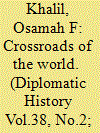

|
|
|
|
|
| Publication |
2014.
|
| Summary/Abstract |
In this paper, I argue that the "Middle East" is an ideational construct maintained by geographical, intellectual, and ideological representations. I assert that the geographical boundaries of the area called the Middle East have shifted over the past century to reflect the strategic interests of the major hegemonic power in the region, initially Britain and later the United States. Drawing on published and archival sources, I trace the etymology of the "Middle East" and its accompanying geographical representations and their relationship to key American and British foreign policy decisions and declarations. I also discuss how the Arabic translation of the "Middle East," or al-Sharq al-Awsa?, has been adopted and contested by scholars and journalists in the region.
|
|
|
|
|
|
|
|
|
|
|
|
|
|
|
|
| 2 |
ID:
132017
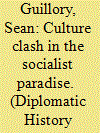

|
|
|
|
|
| Publication |
2014.
|
| Summary/Abstract |
The encounters between Soviet citizens and African students studying in the Soviet Union in the sixties inevitably generated problems of acclimation, social and political conflict, and racial strife. The article illuminates the ways the cultural clash affirmed Russians' and Africans' sense of cultural superiority. The African presence in Russia confirmed Soviet altruism in rearing Africans into cultured and scientifically endowed people. Similarly, African encounters with Soviet daily life reaffirmed their identity as culturally superior to Russians by emphasizing aspects of the individual that directly conflicted with Soviet notions of collectivism. The conflict over culturedness had direct ramifications on the Cold War as it strengthened Africans' pragmatic stance toward Soviet patronage and their reluctance to embrace Soviet ideology and values.
|
|
|
|
|
|
|
|
|
|
|
|
|
|
|
|
| 3 |
ID:
132022
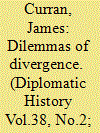

|
|
|
|
|
| Publication |
2014.
|
| Summary/Abstract |
In the period from December 1972 until November 1975 the US-Australia alliance faced its greatest ever crisis. In the hands of President Richard Nixon and Australian Prime Minister Gough Whitlam, a relationship that had endured the heights of the Cold War veered dangerously off course and seemed headed for destruction. For Whitlam the world emerging from the ashes of Vietnam offered an exciting opportunity to recast Australia's image in the eyes of the world and redefine the alliance. For Nixon, the ongoing difficulties in securing an end to the war and the mounting pressures of the Watergate scandal produced a visceral reaction to any criticism-but especially that from once close and trusted allies. In his rage he threatened to rip apart the very fabric of the alliance, asking that options be explored for pulling out top secret U.S. intelligence installations in Australia and ending all intelligence sharing. In Australia, although some saw Whitlam as the great modernizer of Australian foreign relations, others feared he was recklessly endangering the protective umbrella provided by the United States.
|
|
|
|
|
|
|
|
|
|
|
|
|
|
|
|
| 4 |
ID:
132023
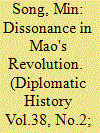

|
|
|
|
|
| Publication |
2014.
|
| Summary/Abstract |
Following President Richard Nixon's visit to China in February 1972, U.S.-China trade increased almost ten-fold within three years, of which China's agricultural imports represented the largest category. This trade created unprecedented opportunities for the Chinese pragmatists to pursue economic modernization, and sharpened the conflict between them and the radicals who adhered to Mao Zedong's ideological crusade. Drawing on both English and Chinese sources, this article examines the fluctuations of China-U.S. agricultural trade between 1972 and 1978. It focuses on the process of trade management in an ideologically charged environment, specifically, the interactions between the pragmatists and radicals under the dominance of Mao. It argues that this trade brought tremendous pressure on the very framework of that Chinese system, tested the boundaries of Mao's revolutionary ideology, and encouraged a fundamental change of course in China.
|
|
|
|
|
|
|
|
|
|
|
|
|
|
|
|
| 5 |
ID:
132015
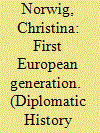

|
|
|
|
|
| Publication |
2014.
|
| Summary/Abstract |
This article explores the central role of youth in the process of European integration. Analyzing the sources of the European Youth Campaign, an international program implemented by the European Movement in the fifties, it focuses on the symbol of youth in discourse on European integration, as well as on the historical agency of young people. After World War II, Europeans conceptualized a future united Europe in terms of "youthfulness" to distinguish the new era from the continent's violent past. Young people also referred to the traditional "myth of youth" in their statements and actions. By staging themselves as a "first European generation," they staked claims to agency in the process of building a new united Europe. Various examples of youth projects reveal the actual role of young people as historical agents and show how the politics of European integration and the Cold War played out at a grass-roots level. With their participation, young people not only helped to constitute the prevailing power constellations; they also challenged them.
|
|
|
|
|
|
|
|
|
|
|
|
|
|
|
|
| 6 |
ID:
132021
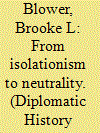

|
|
|
|
|
| Publication |
2014.
|
| Summary/Abstract |
This essay assesses the pitfalls of relying on isolationism to describe American political culture during the 1920s and 1930s and proposes that the concept of neutrality offers a more useful framework for understanding how Americans struggled with their place in a world at war. Americans had long worried about foreign entanglements, but what lent the debates after World War I their special urgency and potency was a sense that one important option in the traditional conduct of international relations-neutrality-had become unhinged from its moorings. Understanding the shifting meanings, and ultimately the perceived demise of neutrality as a viable form of statecraft, points toward a new way to narrate the turning points and political alliances of the interwar years. It also helps to explain why, since the 1930s, Americans have become more readily embroiled in military conflicts overseas despite their recurring doubts about the price of such engagement.
|
|
|
|
|
|
|
|
|
|
|
|
|
|
|
|
| 7 |
ID:
132016
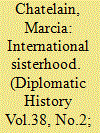

|
|
|
|
|
| Publication |
2014.
|
| Summary/Abstract |
After World War II, the Girl Scouts of the United States of America identified international friendship as a key component of its program. In 1957, the Girl Scouts partnered with their international counterparts, the World Association of Girl Guides, to establish Our Cabaña, an international meetinghouse in Cuernavaca, Mexico, where Girl Scouts could meet and befriend fellow members from around the globe. Soon after opening Our Cabaña, leaders noticed that some Girl Scouts repeatedly ignored rules about proper behavior in Mexico, and they feared that Scouts would alienate their Guide sisters and poorly represent the United States. This article asserts that responses to the problems at Our Cabaña demonstrate a critical shift in Girl Scouts' stance on what constituted a good girl ambassador; the organization evolved from promoting manners in intercultural settings to declaring that cultural sensitivity was necessary for girls to become global citizens.
|
|
|
|
|
|
|
|
|
|
|
|
|
|
|
|
| 8 |
ID:
132019
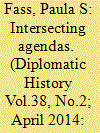

|
|
|
|
|
| Publication |
2014.
|
| Summary/Abstract |
These five articles allow us to think about the history of childhood and the history of international affairs as intersecting forms of inquiry in ways not usually proposed, and their diversity of focus and approach make the encounter eye-opening. In collecting papers set in North America, the Soviet Union, a nascent united Europe, as well as Asia and Africa, the organizers of the initial conference have brilliantly suggested just how widespread and potentially powerful this intersection might be and how fertile a field they are opening up for future development.
|
|
|
|
|
|
|
|
|
|
|
|
|
|
|
|
| 9 |
ID:
132014
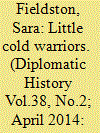

|
|
|
|
|
| Publication |
2014.
|
| Summary/Abstract |
During the two decades following World War II, American voluntary agencies including Christian Children's Fund, Foster Parents' Plan, and the Save the Children Federation ran child sponsorship programs that allowed American' foster parents' to send funds and exchange letters with youngsters in war-torn and poverty-stricken countries around the world. These programs were at once humanitarian gestures and political projects. American sponsorship agencies sought to forge international friendships that would support the United States' political alliances and mold children into strong democratic citizens who would join the fight against communism. Enlisting familial ideals in the service of U.S. foreign policy, American child sponsorship agencies rendered love itself a powerful Cold War weapon.
|
|
|
|
|
|
|
|
|
|
|
|
|
|
|
|
| 10 |
ID:
132018
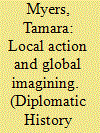

|
|
|
|
|
| Publication |
2014.
|
| Summary/Abstract |
In the late sixties Canadian young people drew attention to global humanitarian crises through the relatively recent innovation of the hunger march. At its peak of popularity, the Miles for Millions walkathon functioned not only as a fundraising tool but as a consciousness-raising vehicle around issues of global significance, including famine, poverty, and war. Children and youth played both symbolic and material roles in the emergence of international development politics and praxis and were fundamental to making the walkathons a spectacular fundraising success. The Walk helped hundreds of thousands of young people imagine themselves belonging to a transnational community in which children mattered. At the same time, imagining global connections between children and youth became intrinsic to Canadian students' sense of nation that insisted on the importance of the country's response to international need. Empathic, emphatic, idealistic, and at times naïve, Canadian youth met the challenge of the Miles for Millions walkathon and were responsible for the millions of foundational dollars raised for the era's international development projects.
|
|
|
|
|
|
|
|
|
|
|
|
|
|
|
|
| 11 |
ID:
132024
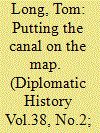

|
|
|
|
|
| Publication |
2014.
|
| Summary/Abstract |
In the early 1970s, Panama's negotiations with the United States over the status of the Panama Canal ground to a standstill. General Omar Torrijos had rejected treaties left unratified by previous governments only to receive a less generous offer from the Nixon administration. Realizing that the talks were being ignored in Washington, the Panamanian government worked to internationalize the previously bilateral issue, creating and exploiting a high-profile forum: Extraordinary meetings of the UN Security Council in March 1973 held in Panama City. In those meetings, Panama isolated the United States in order to raise the issue's profile and amplify the costs of leaving the matter unsettled. Using underutilized Panamanian sources, this article examines that meeting, the succeeding progress, and the effect of this early stage on the final negotiations several years later. The case also illustrates how, during the unsettled international environment of the 1970s, a small state utilized international organizations to obtain attention and support for its most important cause.
|
|
|
|
|
|
|
|
|
|
|
|
|
|
|
|
| 12 |
ID:
132013
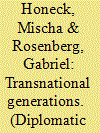

|
|
|
|
|
| Publication |
2014.
|
| Summary/Abstract |
The Cold War had just turned hot on the Korean Peninsula in late June 1950 when Deon Smith, a young Boy Scout from Mt. Vernon, Illinois, pitched his tent in Valley Forge. Fears of a global cataclysm loomed over the Revolutionary War battlefield, where nearly 50,000 Boy Scouts from the United States and twenty allied nations had gathered to celebrate Independence Day. Their jamboree marked the biggest encampment of youth on American soil to date, big enough to garner an address by President Harry Truman. "I hope that you young men … will take home from this jamboree a clearer understanding of the meaning of human brotherhood," said Truman. "I hope that you will work for freedom and peace with the same burning faith that inspired the men of George Washington's Army here at Valley Forge."1 Given the geopolitical context, the subtext was clear: "freedom and peace" required the "burning faith" of fighting men. Irony, as well as faith, burned in Truman's comments. Beyond the rhetoric of global brotherhood, Truman's internationalist overtures obscured particular national geopolitical interests on the peninsula and cast communism as an inhuman menace. Meanwhile, even as the grand statesman rallied the crowd, Deon Smith was busy forging international ties of his own-ties that did not grow out of security concerns but were driven by juvenile excitement and curiosity. He took part in various "Scoutcraft events" and "inter-camp visits," traded souvenirs with his distant peers, and formed friendships with Scouts from near and far. "Some of the most interesting groups we have met," Smith wrote, "are the Scouts from foreign lands," including boys from the former enemy nations of Germany and Japan. In this, Smith explored internationalism rather than merely assuming it. Who, then, assembled universal brotherhood more decisively at this jamboree: the president, whose speech recoded the chaos, flux, and pleasures of a sprawling encampment in the overdetermined, ironically nationalist registers of liberal internationalism, or the boy, whose handshakes gave literal flesh to Truman's rhetoric?2
|
|
|
|
|
|
|
|
|
|
|
|
|
|
|
|
|
|
|
|
|